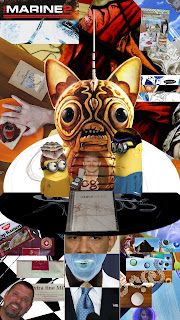1.) The reading suggests that "as technology advances, so does the human sensory perception needed to receive it." However, technology continues to advance beyond the normal capabilities of human perception. For instance, video resolution is becoming almost indistinguishable from the real thing, and frame capture is available above a standard human's rate of 60 fps. If human sensory perception does evolve jointly to technological advances, do you believe humans to be able to break this visual limitations naturally without the use of surgical augmentation?
2.) Since Sony making the first portable video camera, the regular population has been given more and more power to influencing and generating media. It was no longer a right almost exclusive to the government or larger news networks. Today, it can even be argued that to the average American, government and large news network media is actually overshadowed by "at-home" generated media. An average American may not know what the big headline is in the news, but may be familiar with the latest meme trending the web. Between government and local/national news networks and the general population, who do you believe has the bigger media influence overall? Whereas in a government or local/national news network dominant culture censorship and other media manipulation is the main problem, what do you believe the problems of a people dominate news culture?
Tuesday, September 24, 2013
Tuesday, September 17, 2013
Animation w/ Audio
I found bringing this animation to life with audio was quite easy. The animation was originally designed with many cliches and parodies to familiar works, so adding the sound was no problem at all. Without sound, I felt that the video wasn't quite as silly as I wanted it, so being able to add in sound clips from artists such as OneyNG and some of the GI Joe PSA Parodies really helped with that.
OneyNG - http://www.youtube.com/user/OneyNG
GI Joe PSAs - http://www.youtube.com/watch?v=N4OPr_QxoFg&list=PL48743DA668B53AF7
Thursday, September 12, 2013
Project 2: Animation
The inspiration behind this work is the voodoo Pikachu thingy and the Marine dude from my last project. Those two seemed to stick out the most, and I loved toying with the idea of gun vs sword. I had the idea that I wanted to slice an object in pieces, so I centered my animation around that detail. The Japanese Temple, rising sun sky, and sliding doors were added to complement the way I animated the slicing scene, as it had a very anime vibe to it. The work is called Virtue to hint at some deeper meaning in this video. There is none. It really is just as silly as it is and if you try to find deeper meaning you are an idiot.
Tuesday, September 10, 2013
Reading #1: Walter Bengamin Reading Critical Questions
Question 1: Walter describes a term aura as "that which withers in the age of mechanical reproduction." This is the loss in a work of art from the original. However, this is all dependent on the human perception of this work. With the strides in technology, it technology can now capture certain objects with even more complexity and depth than what can be viewed with the human eye. For instance, a human can only view at 60 frames per second, however we now have cameras that can capture at 100+ fps. In cases like this, do you believe the "aura" to actually be positive gain instead of negative loss from the original?
Question 2: In section VIII, Walter discusses the differences in a stage act and a film. He states one of the main differences is with whom the audience will associate with. He states that "The audience’s identification with the actor is really an identification with the camera". Both representations, film and stage performance, limit the scope to which the audience sees the work. Film shows the work through the eyes of the camera, which tries to capture the idea viewpoint as per the director's will. Stage deletes the middle/camera man, and allows for personal view; however, this is done strictly from only one static viewpoint as opposed to a dynamic viewpoint found in film. Which method do you believe allows for the most personal interpretation from an individual? Is there even a difference?
Question 2: In section VIII, Walter discusses the differences in a stage act and a film. He states one of the main differences is with whom the audience will associate with. He states that "The audience’s identification with the actor is really an identification with the camera". Both representations, film and stage performance, limit the scope to which the audience sees the work. Film shows the work through the eyes of the camera, which tries to capture the idea viewpoint as per the director's will. Stage deletes the middle/camera man, and allows for personal view; however, this is done strictly from only one static viewpoint as opposed to a dynamic viewpoint found in film. Which method do you believe allows for the most personal interpretation from an individual? Is there even a difference?
Tuesday, September 3, 2013
Ask Google - Digital Triptych Montage
Statement: This is my first project in ART 245 - the Digital Triptych Montage. The name of the work is "Ask Google". This was made exclusively through Adobe Photoshop CS6 using some cuts from political magazines, speedily written text, and my BFF Google.
The inspiration behind this work is indecision. As a CS major, I am not used to having the ability to be creative, so finding out what I wanted to put in my project was stifling. I was overwhelmed by the freedom of choice, so instead I just used Google image search to find "Things JC Likes". My BFF Google bailed me out and provided me with a plethora of images that JC likes, so I went ahead and used random images from the generated search. Thanks Google.
Subscribe to:
Comments (Atom)


